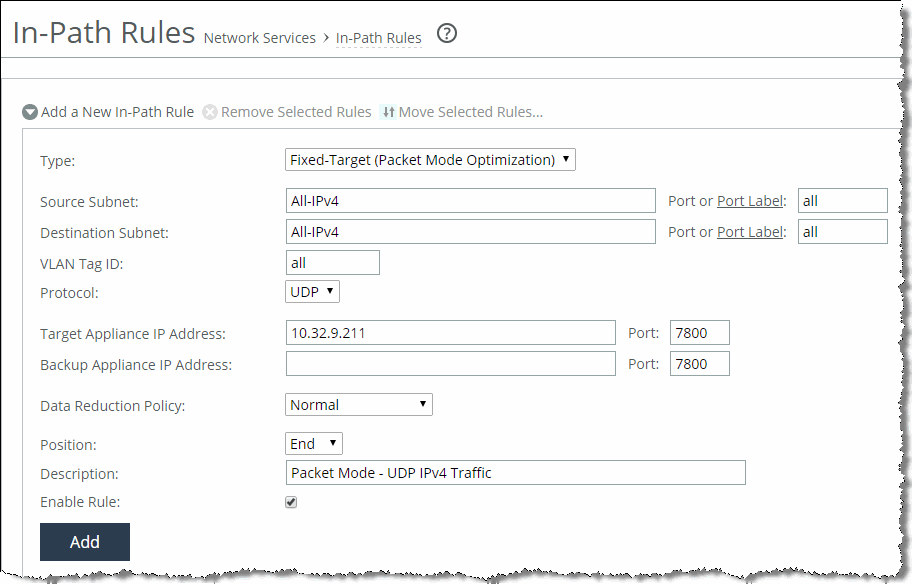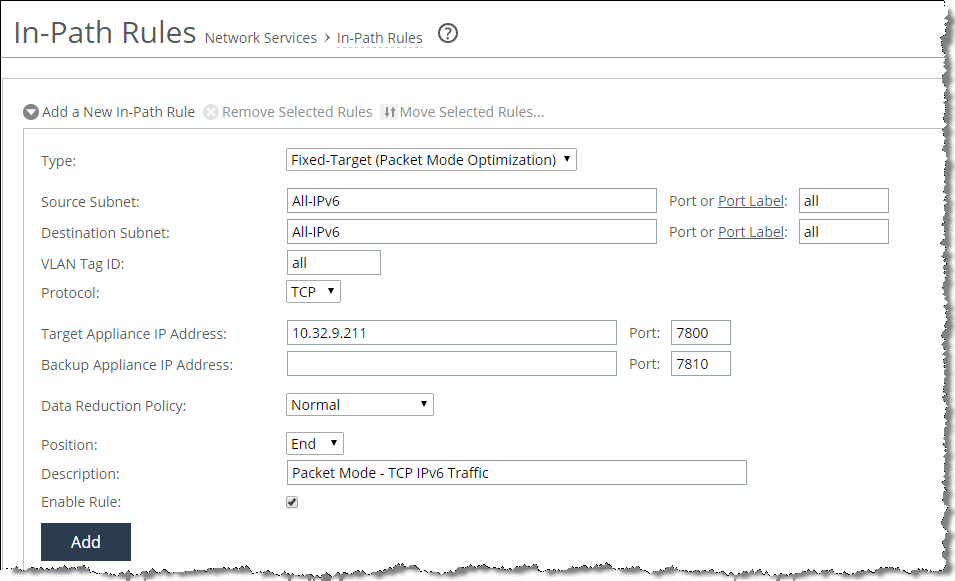Configuring Packet Mode Optimization
This section describes how to configure packet mode optimization for UDP IPv4 and TCP IPv6 traffic.
Packet mode optimization supports only correct addressing. Packet mode optimization does not support auto-discovery and requires that you configure fixed-target, packet-mode, in-path rules.
For more design details, see
Design Considerations.
the following example shows UDP traffic.
To configure packet mode optimization for IPv4 traffic
From the Management Console, choose Optimization > Network Services: General Service Settings and select Enable Packet Mode Optimization; otherwise, use the CLI command packet-mode enable.
Configure a fixed-target (packet mode optimization) in-path rule on the initiating SteelHead.
To optimize traffic in both directions, you must configure a similar in-path rule on the peer SteelHead.
Figure 14‑1 shows an example that creates an in-path rule with the following key settings.
Field | Option | Description |
Type | Fixed-target (packet mode optimization) | Rule type for performing packet mode optimization. |
Source subnet | all-IPv4 | Selects all IPv4 addresses. You can choose specific IP addresses or ranges. |
Destination subnet | all-IPv4 | Selects all IPv4 addresses. You can choose specific IP addresses or ranges. |
Protocol | UDP | Selects optimization of TCP, UDP, or any type of traffic. |
Target appliance IP address | 10.32.9.211 | Specifies the remote SteelHead to optimize to. You must specify a target with a fixed-target rule. You can also specify a backup appliance. A backup SteelHead is not specified in this example. |
Data reduction policy | Normal | Specifies SDR, LZ, or both for data reduction. Normal usage includes both. |
Position | l | Determines which position the rule is in the rule list. You can decide this based on your environment. |
Figure 14‑1. Fixed-Target (Packet Mode Optimization) Rule for UDP IPv4 Traffic

Click Add.
To optimize IPv6 traffic, you must enable packet mode optimization and create a fixed-target packet-mode rule similar to IPv4 traffic, but you must make sure to enable IPv6 (IPv6 is enabled by default) and configure an IPv6 setting on the SteelHead in-path interfaces.
This example shows TCP traffic.
To configure packet mode optimization for IPv6 traffic
From the Management Console, choose Optimization > Network Services: General Service Settings, otherwise use the CLI command packet-mode enable.
Configure a fixed-target (packet mode optimization) in-path rule on the initiating SteelHead.
To optimize TCP traffic in both directions, you must configure a similar in-path rule on the peer SteelHead.
Figure 14‑2 shows an example that creates a rule with the following key settings.
Field | Option | Description |
Type | Fixed-target (packet mode optimization) | Rule type for performing packet mode optimization. |
Source subnet | all-IPv6 | Selects all IPv6 addresses. You can choose specific IP addresses or ranges. |
Destination subnet | all-IPv6 | Selects all IPv6 addresses. You can choose specific IP addresses or ranges. |
Protocol | TCP | Selects optimization of TCP, UDP, or any type of traffic. |
Target appliance IP address | 10.32.9.211 | Specifies the remote SteelHead to optimize to. You must specify a target with a fixed-target rule. You can also specify a backup appliance. A backup SteelHead is not specified in this example. |
Data reduction policy | Normal | Specifies SDR, LZ, or both for data reduction. Normal usage includes both. |
Position | l | Determines which position the rule is in the rule list. You can decide this based on your environment. |
Figure 14‑2. Fixed-Target (Packet Mode Optimization) Rule for TCP IPv6 Traffic

Click Add.
Connect to the Riverbed CLI. You can also use the SteelHead Management Console.
Enable IPv6.
IPv6 is enabled by default, unless you are using versions of RiOS prior to v8.0.
Configure an IPv6 address on a SteelHead in-path interface: interface inpathX_Y ipv6 address <addr> <masklen>.
Add IPv6 routes: ipv6 in-path route inpathX_Y <prefix> <prefix len> <nexthop v6 addr>.
For example, ipv6 in-path route inpath0_0 0::0/0 ba5e:ba11:bab3:f005:ba11:bab3:dead:bea7 sets a default IPv6 gateway.



